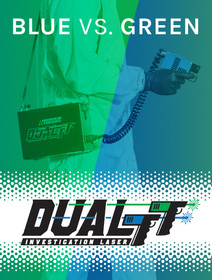Posted by QC on 1st Aug 2018
Dual77: Blue vs. Green
For years, green lasers were utilized solely for latent print examination. However, alternate light sources diversified wavelengths, making forensic light sources applicable outside of the lab. Now, multiple wavelengths, specifically blue and green, are offered with the narrow bandwidth and power of forensic lasers, providing versatility when processing for different types of evidence. This article discusses the differences and specific uses of blue and green forensic lasers.
WHY BLUE?
The blue 445 nm wavelength has not only been proven useful in the detection and documentation of biological and trace evidence, but can also be useful in chemical processing. When searching for biological evidence or serological stains, the 7.2 Watt blue 445 nm laser offered in the DUAL77 will fluoresce biological evidence such as urine, semen, and saliva, that other wavelengths (such as the green 520 nm wavelength) may not detect. Detection of this biological evidence is enabled by the intensity that is unique to laser light. This intensity is often necessary for the documentation of such evidence through photography in conjunction with various barrier filters. Though it excels in this area of biological detection, the blue 445 nm wavelength is also extremely useful in detecting other types of trace evidence, as well as providing fluorescence for latent fingerprint powders and a variety of chemical methods such as: Ardrox, Basic Yellow, MRM10, liquid powder, RAY, MBD, and RAM.

WHY GREEN?
The 6.6 Watt green 520 nm laser offered in the DUAL77 enables investigators to not only process and document evidence, but also detect it, when paired with goggles and filters. Green lasers are often used in processing evidence such as latent fingerprints using fluorescent powders and established chemical methods. These various methods include: 1,2-Indanedione, Rhodamine 6G, MBD, RAM, DFO (1,8-Diazafluoren-9-one), Basic RED, Acid Yellow #7, and Lumicyano. With the help of a laser, treated prints brightly fluoresce and can be photographed using a camera equipped with barrier filters. The 520 nm wavelength is also useful for more than just chemical processing and imagery. It can also be utilized in the search for trace evidence, detecting evidence such as shoeprints, hairs, fibers, and bone/tooth fragment. This versatility makes the green 520 nm wavelength extremely useful in both the lab and in the field.

MORE FROM THIS SERIES:
CONTACT US!
If you would like a copy of the full whitepaper, request one here.
If you need a quote, brochure or additional information about the DUAL77 or any other products, please contact one of our customer service specialists:
Product Info: Brad Brown, brad@arrowheadforensics.com, 913-945-1807
Quotes: Brianna Mccreary, quotes@arrowheadforensics.com, 913-945-1841






